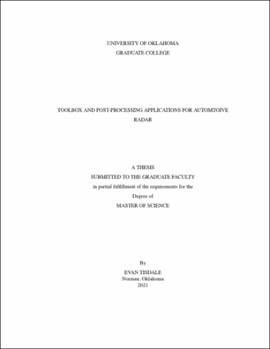| dc.description.abstract | In recent years, companies have pushed the limits to offer partial and fully autonomous driving systems. All vehicles now have a wide array of sensors to aid in driving, ranging from lane assist to automated parallel parking, which culminates into a hybrid system on the verge of complete autonomy. However, Formal adoption by consumers and regulatory agencies still faces justified scrutiny. Self-driving cars will need to drive better and perceive beyond the capabilities of the average driver before being allowed on the road. The ability to capture data for research and algorithm development is necessary. A cheap and reliable automotive radar system can help expand the field and drive the future of automated systems.
This thesis describes the development of a system toolbox using a 77 GHz frequency-modulated continuous-wave (FMCW) radar and video camera for data collection and post-processing applications. System details for the hardware, software, and overview of a custom-made 3D printable mount for vehicles are covered. Hardware specifics dive into using a Texas Instrument’s AWR1642Boost system and DCA1000EVM FPGA capture card with a collocated HD video camera. In addition, the thesis covers the software toolchain used to collect data and prepare it for storage and post-processing. Inside is a detailed explanation of radar signal processing theories and applications with Matlab, including range-Doppler and angle-of-arrival estimation. Additional post-processing topics include radar-video fusion frame synchronization and constant false alarm rate (CFAR) applications in range-Doppler plots.
Results generated in this thesis focus on the setup process of the proposed system and raw analog-to-digital converter (ADC) data with recorded HD video from stationery and vehicle-based measurements. The data includes scenes in neighborhoods, city streets, parking lots, and country roads. Objects included in the dataset are pedestrians, dogs, vehicles, road signs, and potholes. Results include a promising, cheap millimeter-wave automotive setup that has the potential to become a fully-developed radar video fusion system. | en_US |

